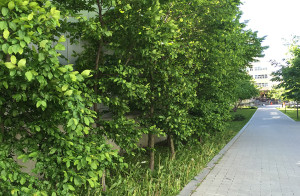The biggest source of air pollution in cities is traffic, and the right type of vegetation can result in better air, particularly if it is growing near traffic. However, there is a key factor that a municipality should take into account before putting the plants in the ground, namely, traffic safety.
“Vision Zero” has long provided important guidance for Swedish traffic safety efforts. The implication of this vision is that while people will continue to make mistakes that lead to accidents, roads, streets, and vehicles must be adapted so as to prevent fatalities and permanent injuries.
“We commonly talk about forgiving road environments, which have to do with removing dangerous objects from along roadways. Bushes and hedges used as boundaries, for instance, are softer to drive into than a tree, but if the vegetation becomes too high or dense, it can obstruct the driver’s view and cause accidents. A plant-covered wall may be great in terms of noise and contribute to better air, but it can also fool the driver into thinking that it is soft and forgiving when it is in fact made of rock-hard concrete”, says Swedish National Road and Transport Research Institute (VTI) air quality researcher Sara Janhäll.
Regulations for green infrastructure
Sara Janhäll is currently working alongside Annika Jägerbrand at VTI on a report about the connections between urban traffic safety and air quality. The report is expected to be completed in the fall.
“In recent years, the importance of vegetation to our well-being has attracted increasing attention, giving us new green infrastructure regulations to comply with. This is fine, but we also have to bear in mind that some measures that are positive for the environment may be negative in terms of traffic safety, and vice versa”, says Janhäll.
Important to reconcile different aspects early in the planning process
In the report, the researchers identify the need to reconcile the green planning done by landscape architects and biologists for a healthier urban environment with engineers’ calculations and plans for architecture, building, logistics, and maintenance.
“It is extremely important to address these different aspects early in the planning process. At present it is not entirely uncommon for different professions that possess knowledge of importance in urban planning to formulate separate plans, each going its own way. The further one goes in the planning process, the harder it becomes to reconcile these different perspectives”, concludes Janhäll.
 Contact: Contact:Sara Janhäll, Researcher sara.janhall@vti.se VTI, Sweden |







Follow us: